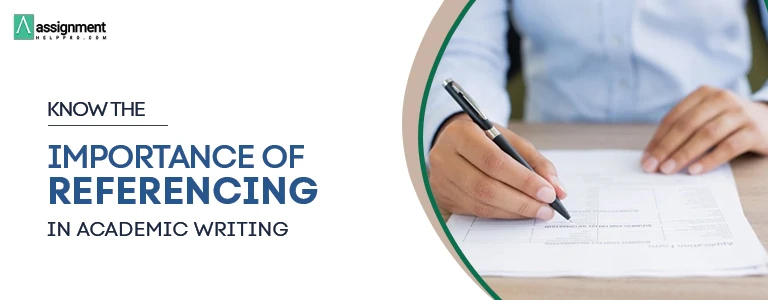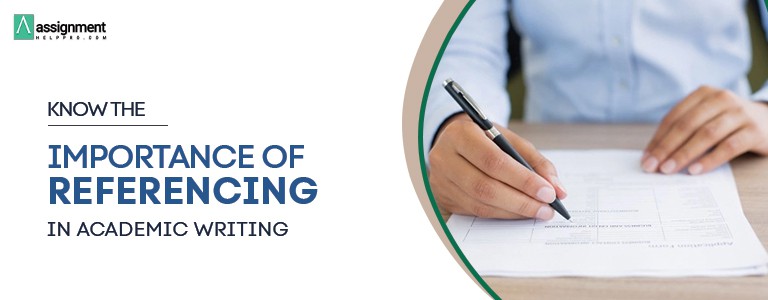Writing an assignment is an important part of academic life. If you want to score high marks for your assignments, then you need to submit high-quality, plagiarism-free, and error-free content. To submit error-free content, you must have good language knowledge. But when it comes to writing unique content, it is usually tough, and so you can refer to the work of others related to your topic and write content based on those references. Remember, referencing is different from copying. When you take references or get inspired by other writers’ work, then make it a habit to cite those sources in your work, or else, it will be treated as copied content. In order to make your work genuine, it is mandatory to do referencing. If you want to know in detail about referencing, its types, and the importance of referencing in academic writing, then continue reading this blog post.
What is Referencing?
Referencing or citation is a method of giving credit to someone’s work that you have used in your research. It helps in identifying the originality of the thoughts and ideas used in the research activity. For your academic assignment or research work, you can take references from the following sources.
- Books
- Journal articles
- Magazines
- Newspapers
- Websites
- Online discussion forums
- Interviews
- Brochures
- Documentaries
- Printed pictures or diagrams
Learn How to do Academic Referencing
As previously stated, when you submit your academic writing, include the references list. Any academic referencing style and format are acceptable for the citations.
When using any style of referencing, you should include the following.
- The Author’s Name
- Date of Publication
- Details of the publishing company
- Name of the book or the title of the journal
- Title of the chapter’s name or research
- Digital Object Identifier(DOI)
When you add references, you should typically use one of the two fundamental approaches.
Method 1: As an “in-text citation,” you need to provide a brief reference to the work in the body section.
Method 2: in a list format, you need to mention a detailed reference list containing all the references at the end of the paper.
Different Types of Referencing or Citation Styles
Referencing styles or citation styles are the various standard referencing methods that you can use to cite the original source of work. Listed below are the different types of referencing styles.
- Harvard
- American Psychological Association (APA)
- Modern Language Association (MLA)
- Chicago/ Turabian
- Vancouver
- Australian Guide to Legal Citation (AGLC)
- American Chemical Society (ACS)
- American Medical Association (AMA)
- Institute of Electrical and Electronics Engineers (IEEE)
- Council of Science Editors/Council of Biology Editors (CSE/ CBE)
Harvard, APA, and MLA are some commonly used referencing styles in academic writing. The referencing styles generally differ based on their formatting, order of information, and punctuation. Always be sure to follow the referencing or citation styles as prescribed by your academic institution or publisher.
Till now, we have learned about referencing and the different types of citation styles. Now, let us move on and see the need for referencing.
Why is it Necessary to Do Referencing in Academic Writing?
The presentation of ideas, information, arguments, or counterarguments on any subject is always the focus of academic writing. When writing academic assignments, you may need to use the work of other writers or research ideas as evidence to support your opinions or share information about a topic. Therefore, you must include references in your paper to give credit to the original author.
When you use referencing, your readers will be able to quickly identify the original sources of your research, which will make it simpler for them to access and comprehend the information contained in the sources. Additionally, referencing distinguishes your paper.
Importance of Referencing in Academic Writing
So, why is referencing important in academic writing? Referencing is one of the credible sections that need to be included in academic papers because it holds a lot of advantages. Not just academic writers, but the readers and the authors of the original sources can also earn benefits from referencing.
Discussed below are some key points on the importance of referencing in academic writing.
Adds value to the author
Giving credit to the original author of the source material using a proper citation style is important because when you mention their name in your paper, then obviously their work will get exposed to a larger set of audience.
Opens a new door of knowledge
When you write an academic paper, it is common for you to search for more information about your topic in relevant sources like books, research papers, magazines, etc. By referring to other sources, you will definitely earn more knowledge about your topic, but when you cite all those referred sources in your paper, your readers will also gain more knowledge about that topic along with you by checking those sources.
Improves authenticity
Referencing or Citations will make your work authentic. Especially, your readers will become more interested when they see any source material from a renowned author in the relevant field mentioned in your reference list. Also, the citation list helps your readers to believe that your work is genuine.
Stands as evidence
Referencing supports the ideas of your work with evidence. In order to highlight your argument or opinion about a topic, strong evidence is needed. So, you can use the ideas or points discussed in the external resources relevant to your topic’s evidence and then cite those sources in your paper. The sources in your citation list will stand as a piece of evidence for your work.
Persuades the readers
With the help of references from published sources, you can develop a persuasive argument and defend them strongly by using the finding and proven points from the completed studies or research.
Eliminates plagiarism
Plagiarism is a legal issue. If you add a references list to your paper, then you can easily avoid plagiarism troubles. Also, your academic paper will look original.
Must read: What is Emotive Language? Definition, Example, Use, and Benefits
Final Words
We hope you have now gained a better understanding of referencing, referencing styles, and the importance of referencing in academic writing. Whenever you prepare academic papers, make sure to add the references list as per the citation methods and styles in your academic paper. The reason is that, referencing usually shows how well you have understood the topic you are working on. Moreover, you will be counted as a better writer only if you write academic papers with proper citation styles. Also, your work will be considered credible only if you use references.
In case, you have any doubts about how to use referencing styles in your academic paper, feel free to reach out to us. The academic experts on our platform will offer high-quality assignment help and will also quickly clarify all your queries regarding referencing. Moreover, with the support of our professionals, before the deadline, you can submit plagiarism-free academic papers with proper citations and evidence.
1. What does referencing mean in writing?
In writing, referencing means listing the details of the sources that helped you to construct the paper. For example, author name, book name, publisher, publishing year, journal name and volume, article name, website name, name of the blogger, news channels name, reporter’s name, news publishing date, link of the web article, YouTube content creator’s name, video title, video link and so on.
2. What is referencing in academic writing?
In academic writing, referencing means a list of the online and offline help you have taken to develop your academic paper. No matter what type of source (books, journal articles, research papers, web articles, blogs, and videos) you have consulted with, you have to include everything. This is a way of giving credit to the real authors to help you in the paper.





